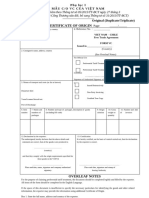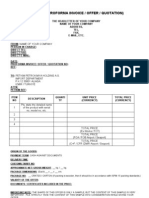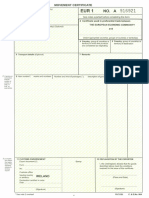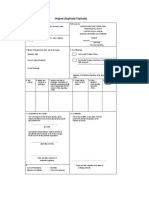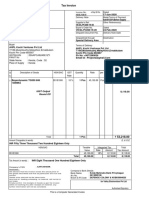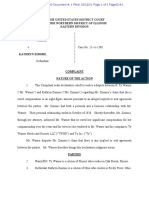cn23 Neutral
cn23 Neutral
Uploaded by
icke2845729Copyright:
Available Formats
cn23 Neutral
cn23 Neutral
Uploaded by
icke2845729Original Title
Copyright
Available Formats
Share this document
Did you find this document useful?
Is this content inappropriate?
Copyright:
Available Formats
cn23 Neutral
cn23 Neutral
Uploaded by
icke2845729Copyright:
Available Formats
(Designated operator) CUSTOMS DECLARATION CN 23
From Name
Sender’s customs
reference (if any)
No. of item (barcode, if any) May be opened officially Important!
See instructions
on the back
Business
Street Tel. No.
Postcode City
Country
To Name
Business
Importer/addressee reference (if any) (tax code/VAT No./importer code) (optional)
Street Tel. No.
Postcode City Importer/addressee fax/e-mail (if known)
Country
For commercial items only
Net weight
Detailed description of contents (1) Quantity (2) Value (5)
(in kg) (3) HS tariff number (7) Country of origin of goods (8)
Total gross weight (4) Total value (6) Postal charges/Fees (9)
Category of item (10) Commercial sample Other (please specify): Office of origin/Date of posting
Gift Returned goods Explanation:
Documents Sale of goods
Comments (11): (e.g.: goods subject to quarantine, sanitary/phytosanitary inspection or other restrictions)
I certify that the particulars given in this customs decla-
ration are correct and that this item does not contain any
dangerous article or articles prohibited by legislation or
by postal or customs regulations
Licence (12) Certificate (13) Invoice (14) Date and sender’s signature (15)
No(s). of licence(s) No(s). of certificate(s) No. of invoice
Size 210 x 148 mm
CN 23 (back)
Instructions
You should attach this customs declaration and accompanying documents securely to the outside of the item, preferably in an adhesive transparent envelope.
If the declaration is not clearly visible on the outside, or if you prefer to enclose it inside the item, you must fix a label to the outside indicating the presence of a
customs declaration.
To accelerate customs clearance, complete this declaration in English, French or in a language accepted in the destination country. If available, add importer/
addressee telephone number and e-mail address, and sender telephone number.
To clear your item, the Customs in the country of destination need to know exactly what the contents are. You must therefore complete your declaration fully and
legibly; otherwise, delay and inconvenience may result for the addressee. A false or misleading declaration may lead to a fine or to seizure of the item.
Your goods may be subject to restrictions. It is your responsibility to enquire into import and export regulations (prohibitions, restrictions such as quarantine,
pharmaceutical restrictions, etc.) and to find out what documents, if any (commercial invoice, certificate of origin, health certificate, licence, authorization for goods
subject to quarantine (plant, animal, food products, etc.) are required in the destination country.
Commercial item means any goods exported/imported in the course of a business transaction, whether or not they are sold for money or exchanged.
(1) Give a detailed description of each article in the item, e.g. “men’s cotton shirts”. General descriptions, e.g. “spare parts”, “samples” or “food products” are not
permitted.
(2) Give the quantity of each article and the unit of measurement used.
(3) and (4) Give the net weight of each article (in kg). Give the total weight of the item (in kg), including packaging, which corresponds to the weight used to
calculate the postage.
(5) and (6) Give the value of each article and the total, indicating the currency used (e.g. CHF for Swiss francs).
(7) and (8) The HS tariff number (6-digit) must be based on the Harmonized Commodity Description and Coding System developed by the World Customs
Organization. “Country of origin” means the country where the goods originated, e.g. were produced/manufactured or assembled. Senders of commercial items
are advised to supply this information as it will assist Customs in processing the items.
(9) Give the amount of postage paid to the Post for the item. Specify separately any other charges, e.g. insurance.
(10) Tick the box or boxes specifying the category of item.
(11) Provide details if the contents are subject to quarantine (plant, animal, food products, etc.) or other restrictions.
(12), (13) and (14) If your item is accompanied by a licence or a certificate, tick the appropriate box and state the number. You should attach an invoice for all
commercial items.
(15) Your signature and the date confirm your liability for the item.
You might also like
- Sartori, Giovanni, Comparative Constitutional Engineering. An Inquiry Into Structures, Incentives and OutcomesDocument3 pagesSartori, Giovanni, Comparative Constitutional Engineering. An Inquiry Into Structures, Incentives and OutcomesSilvia Trasca100% (1)
- Roberts Rules of OrderDocument4 pagesRoberts Rules of OrderJoel Shango Byam100% (2)
- CN23 PDFDocument2 pagesCN23 PDFRajeev KhullarNo ratings yet
- HM Revenue & Customs - Form CN23 - 2012Document2 pagesHM Revenue & Customs - Form CN23 - 2012alain_oregioniNo ratings yet
- CN23 PDFDocument2 pagesCN23 PDFRajeev KhullarNo ratings yet
- CN 23 enDocument2 pagesCN 23 enVENU42908No ratings yet
- CN23Document2 pagesCN23Rajeev KhullarNo ratings yet
- Customs Declaration Form cn23Document2 pagesCustoms Declaration Form cn23Hamza KhanNo ratings yet
- CN23Document2 pagesCN23DMCC chennaiNo ratings yet
- CN23Document2 pagesCN23Rajeev KhullarNo ratings yet
- CN2311Document1 pageCN2311aishwary.bandal9No ratings yet
- CN23newDocument1 pageCN23newaishwary.bandal9No ratings yet
- CN 23Document1 pageCN 23Kamil MaskNo ratings yet
- CN23Document1 pageCN23Kamil MaskNo ratings yet
- Peut-Être Ouvert D'o Ce Gift/Cadeau Commercial Sample/echantillon Commercial Documents Other/AutreDocument4 pagesPeut-Être Ouvert D'o Ce Gift/Cadeau Commercial Sample/echantillon Commercial Documents Other/AutreJefNo ratings yet
- Arshad Bibi CN23Document2 pagesArshad Bibi CN23chaudharycomputers.composingNo ratings yet
- Receipt Booking1Document1 pageReceipt Booking1Triono HandokoNo ratings yet
- receipt_booking-1Document1 pagereceipt_booking-1riskatiaraapriliaNo ratings yet
- Receipt BookingDocument1 pageReceipt BookingFR ChannelNo ratings yet
- Julia HahnelDocument1 pageJulia HahnelRoni -No ratings yet
- Receipt Booking United StateDocument1 pageReceipt Booking United StateMoch. Arif Bayu Setia BudiNo ratings yet
- Receipt BookingDocument1 pageReceipt BookingFairuz FaaNo ratings yet
- Name-KAISRA: 5 Ta 10, Housing Board, Shastri Nagar, 302016 Jaipur IndiaDocument2 pagesName-KAISRA: 5 Ta 10, Housing Board, Shastri Nagar, 302016 Jaipur IndiaSunny KumarNo ratings yet
- Receipt - Booking - 2023-03-30T160201.352Document1 pageReceipt - Booking - 2023-03-30T160201.352Ir AwNo ratings yet
- Form-Ii (See Regulation 4) Postal Bill of Export - II (To Be Submitted in Duplicate)Document1 pageForm-Ii (See Regulation 4) Postal Bill of Export - II (To Be Submitted in Duplicate)mrthilagamNo ratings yet
- Mau C o Mau D Moi Nam 2022 - 0606154711Document5 pagesMau C o Mau D Moi Nam 2022 - 0606154711vohongoanh09No ratings yet
- Phụ lục I (6)Document2 pagesPhụ lục I (6)ngohang.cofoNo ratings yet
- Receipt BookingDocument1 pageReceipt Bookingleonitaria officialNo ratings yet
- Declaration en Douane: Sender Customs Reference (If Any)Document1 pageDeclaration en Douane: Sender Customs Reference (If Any)NUR SAIDNo ratings yet
- China FJ fj3 enDocument7 pagesChina FJ fj3 enjverdugo272015No ratings yet
- ATIGA 07 Annex 7 Amended CO Form D and Overleaf Notes Endorsed AFTAC35Document3 pagesATIGA 07 Annex 7 Amended CO Form D and Overleaf Notes Endorsed AFTAC35basofi12No ratings yet
- Declaration en Douane: Sender Customs Reference (If Any)Document1 pageDeclaration en Douane: Sender Customs Reference (If Any)NUR SAIDNo ratings yet
- Declaration en Douane: Sender Customs Reference (If Any)Document1 pageDeclaration en Douane: Sender Customs Reference (If Any)lexa darmawanNo ratings yet
- FormeDocument2 pagesFormeBULLY CHANNELNo ratings yet
- Form VN-CUDocument2 pagesForm VN-CUkatacumiNo ratings yet
- EUR1 No.: United Kingdom andDocument4 pagesEUR1 No.: United Kingdom andadnanbajwa141No ratings yet
- LeonDocument1 pageLeonRoni -No ratings yet
- Proforma Invoice With General ConditionsDocument6 pagesProforma Invoice With General ConditionsambrosialnectarNo ratings yet
- Certificate of Origin - FORM ADocument2 pagesCertificate of Origin - FORM ARivanda MilaNo ratings yet
- Phu Luc IIDocument3 pagesPhu Luc IIphonghd04No ratings yet
- receipt_booking (2)Document1 pagereceipt_booking (2)riskatiaraapriliaNo ratings yet
- Eur 1Document4 pagesEur 1Sarah FetahNo ratings yet
- Certificate of Origin Form F For China-Chile FTADocument2 pagesCertificate of Origin Form F For China-Chile FTAinspectormetNo ratings yet
- receipt_booking(1)Document1 pagereceipt_booking(1)riskatiaraapriliaNo ratings yet
- Fyuydt enDocument2 pagesFyuydt enDembele SOULEYMANENo ratings yet
- Development Specifications For The CN 23 Customs DeclarationDocument11 pagesDevelopment Specifications For The CN 23 Customs DeclarationMaddison Charles JoNo ratings yet
- Appendix 1 - Attachment C - Contoh SKADocument2 pagesAppendix 1 - Attachment C - Contoh SKAJundiNo ratings yet
- co-form-d-cho-hang-hoa-xuat-khauDocument4 pagesco-form-d-cho-hang-hoa-xuat-khaungohang.cofoNo ratings yet
- Receipt Booking ItalyDocument1 pageReceipt Booking ItalyMoch. Arif Bayu Setia BudiNo ratings yet
- Declaration en Douane: Sender Customs Reference (If Any)Document1 pageDeclaration en Douane: Sender Customs Reference (If Any)skullterrongNo ratings yet
- Form EDocument1 pageForm EHarenNo ratings yet
- Operational Procedures For Imports Under The Asean-India Free Trade Area (Aifta) Trade in Goods (Tig) AgreementDocument4 pagesOperational Procedures For Imports Under The Asean-India Free Trade Area (Aifta) Trade in Goods (Tig) AgreementDio MaulanaNo ratings yet
- ASEAN India OCP PDFDocument2 pagesASEAN India OCP PDFCha CahNo ratings yet
- Obrasci Uverenja o Kretanju Tekst Izjave Na FakturiDocument14 pagesObrasci Uverenja o Kretanju Tekst Izjave Na FakturiVladimir StojanovicNo ratings yet
- Certificado FORM-A PDFDocument2 pagesCertificado FORM-A PDFAnonymous xtfIrUNo ratings yet
- Certificate of Free SaleDocument1 pageCertificate of Free SaleJhayd ManlapazNo ratings yet
- CDS Liu KeDocument1 pageCDS Liu KeMohammad Khairul UmamNo ratings yet
- For All Articles Value Less Than Rs.23000Document1 pageFor All Articles Value Less Than Rs.23000realrakhiNo ratings yet
- CO Form D AtigaDocument2 pagesCO Form D AtigaDustin SangNo ratings yet
- Certificate of Origining Feb WR PDFDocument3 pagesCertificate of Origining Feb WR PDFLucero GonzalesNo ratings yet
- Cis - DurnezDocument3 pagesCis - Durnezhendrick villegasNo ratings yet
- Audit Report TemplateDocument18 pagesAudit Report TemplatePrincessIrishSaludoNo ratings yet
- Road Traffic Signs and SymbolsDocument26 pagesRoad Traffic Signs and SymbolsPatricia AdrianoNo ratings yet
- Ampatuan DecisionDocument761 pagesAmpatuan DecisionGMA News Online100% (1)
- Laporan Laba RugiDocument3 pagesLaporan Laba RugiAlfiani FadillahNo ratings yet
- Almirez v. Infinite Loop Technology (2006) : FactsDocument5 pagesAlmirez v. Infinite Loop Technology (2006) : FactsyanaNo ratings yet
- Kho v. MakalintalDocument7 pagesKho v. MakalintalmiyumiNo ratings yet
- Surface Vehicle Recommended Practice: Rev. FEB77Document4 pagesSurface Vehicle Recommended Practice: Rev. FEB77anupthattaNo ratings yet
- Outline Land Registration and Torrens SystemDocument25 pagesOutline Land Registration and Torrens SystemGio AvilaNo ratings yet
- SpeechesDocument6 pagesSpeechesAj PotXzs ÜNo ratings yet
- Annexation of Dadra and Nagar HaveliDocument6 pagesAnnexation of Dadra and Nagar HaveliAli100% (1)
- Dual Nature of Local GovernmentDocument26 pagesDual Nature of Local GovernmentAleph JirehNo ratings yet
- 7 AhplDocument1 page7 AhplRahul SahooNo ratings yet
- Test in Business LawDocument3 pagesTest in Business LawAnthony Jude BalaneNo ratings yet
- Math6969 2024Document4 pagesMath6969 2024Gian NataniaNo ratings yet
- BUS - MATH 11 Q1 Module 8Document18 pagesBUS - MATH 11 Q1 Module 8Angel Lou DalugduganNo ratings yet
- Washington Mutual (WMI) - Letter of Request For Information Regarding Disposition of Second & Union LLC Filed by Joe SchorpDocument7 pagesWashington Mutual (WMI) - Letter of Request For Information Regarding Disposition of Second & Union LLC Filed by Joe SchorpmeischerNo ratings yet
- Warranty Against Hidden Defects - This Refers To The Implied Warranty That TheDocument12 pagesWarranty Against Hidden Defects - This Refers To The Implied Warranty That TheSk SynzerNo ratings yet
- PK Debit Card Leaflet 1Document8 pagesPK Debit Card Leaflet 1szsoomroNo ratings yet
- Ty Warner SuitDocument5 pagesTy Warner SuitAnonymous 6f8RIS6No ratings yet
- The Reconstruction and Development of Beirut Central DistrictDocument253 pagesThe Reconstruction and Development of Beirut Central DistrictkaissyaNo ratings yet
- Evidence of Harassment and Possible Murder at 1252 Fremont Street, February 9, 2016Document20 pagesEvidence of Harassment and Possible Murder at 1252 Fremont Street, February 9, 2016Stan J. CaterboneNo ratings yet
- Answers To CES CBT Test About Illegal Passengers On BoardDocument48 pagesAnswers To CES CBT Test About Illegal Passengers On BoardMyo Minn TunNo ratings yet
- Top Markets For Buying Turnkey Rental PropertiesDocument4 pagesTop Markets For Buying Turnkey Rental PropertiesAlena ThweNo ratings yet
- Eduarte v. CA, 253 SCRA 391 (1996)Document17 pagesEduarte v. CA, 253 SCRA 391 (1996)GioNo ratings yet
- Termination of ContractsDocument17 pagesTermination of ContractsDevasish PandaNo ratings yet
- Lease of Properties: ExemptDocument12 pagesLease of Properties: Exemptmariyha PalangganaNo ratings yet
- Tax AssessmentDocument11 pagesTax AssessmentRon VillanuevaNo ratings yet


























